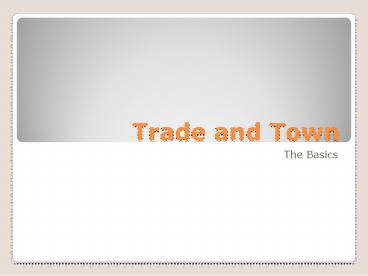Trade and Town - PowerPoint PPT Presentation
1 / 11
Title:
Trade and Town
Description:
Trade and Town The Basics THE BEGINNING The Crusades marked the beginning of trade in Europe. People were tempted by goods such as silk, spices, tapestries, and ... – PowerPoint PPT presentation
Number of Views:71
Avg rating:3.0/5.0
Title: Trade and Town
1
Trade and Town
- The Basics
2
THE BEGINNING
- The Crusades marked the beginning of trade in
Europe. - People were tempted by goods such as silk,
spices, tapestries, and sugar. - Those with money to pay for the expenses of a
trip went into the trading business (who would
that be??)
3
EXPANSION
- Western Europeans began sending ships in search
of the goods they desired. - Originally traders sold their goods in regular
local markets or fairs. - Fairs were social events were people gathered and
browsed, but could also shop.
4
EXPANSION
- People began to see what other areas offered
- Serfs saw that they could sell things in exchange
for money (ticket out of the bottom of the feudal
system) - People began building their skills to make the
goods to be sold in fairs.
5
THE END OF FAIRS
- As expansion happened, fairs were unable to
satisfy all the needs of traders and consumers
because - Fairs were NOT held in winter
- People travelled great distances to be there
- Travelling was dangerous (why??)
6
TOWNS
- Fairs lead way to the development of towns for
the following reasons - They provided stability (year round)
- Shops were permanent (could be set up)
- Towns were protected by a wall (security)
7
CRAFT GUILDS
- Towns were populated by people specializing in
trade bakers, tailors, tanners, sword and armor
makers, etc. - Every trade was controlled by the experts in that
trade (called guilds) - Guilds were organizations that set standards for
the quality of their products. (what do we have
today that mimics this?)
8
- Guilds controlled prices for products, kept out
unskilled crafts people, and eliminated
competition. - They controlled trade activity that took place in
towns. - They handled any accidents that occurred.
- If a member was sick the other members would
provide him with food, etc.
9
- Trades people could only work if they were a
member of a guild - They could only become members if they had been
trained. - Think of modern jobs, does this process still
hold true and in what ways?
10
BECOMING A MEMBER
- Acceptance into a guild followed this process
- The apprentice learned the most simple tasks,.
He or she received training, room and board, and
a small allowance - Then they were sent to live and work under a
particular master (at age 8 or 9). - After years of work the apprentice would take a
test to become a journeyman and would be admitted
into the guild.
11
- After more years as a journeyman (who are paid),
they created a master piece to be judged by
masters for quality. - If accepted they became a master and they could
take apprentices. - WOMEN were limited to guilds in the brewing and
textile industries.































